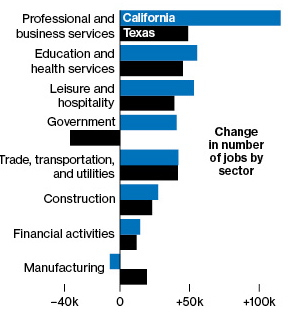 The latest Bloomberg Businessweek offers a brief article suggesting California has gained an advantage over Texas in the race to recover from the depths of the latest economic downturn. California added 365,100 nonfarm jobs in the year that ended in July, compared to 222,500 new jobs in Texas.
The latest Bloomberg Businessweek offers a brief article suggesting California has gained an advantage over Texas in the race to recover from the depths of the latest economic downturn. California added 365,100 nonfarm jobs in the year that ended in July, compared to 222,500 new jobs in Texas.
But the article makes no mention of how many jobs the two states lost at the height of the Great Recession. What was the base to which these respective new job totals added? The Businessweek writers also undercut their own story line with the following paragraphs.
California still has the country’s third-highest unemployment rate, at 10.7 percent, compared with Texas’s 7.2 percent. And although job growth in California has surged ahead recently, Texas has outpaced it in 18 of the past 24 months. “Texas is still the model for job creation and economic growth in this country,” says Josh Havens, a spokesman for Republican Governor Rick Perry. The state has a better credit rating than California, meaning it can borrow at lower rates. In August, Texas sold $9.8 billion worth of one-year notes at 0.23 percent, while California paid 0.33 percent and 0.43 percent on $10 billion of short-term notes.
California has overtaken Texas in the jobs race partially because of cuts the Lone Star State made this year in its public workforce. In 2009 and 2010, Texas lawmakers avoided slashing the government payroll in part by plugging budgetary holes with federal stimulus dollars. Facing an estimated $20 billion deficit last year, Governor Perry signed a two-year budget that slashed state spending, including a $5 billion cut in funding for public education. Over the past year, Texas has shed 36,000 government jobs, a 2 percent drop. The state’s unemployment rate started to rise in June.
Since the public sector lives off proceeds generated from the private sector, Perry and the Texas legislature’s efforts seem perfectly reasonable. If Texas taxpayers can’t afford an inflated public work force, those jobs must go.


